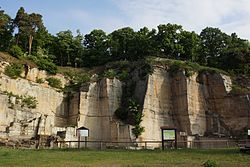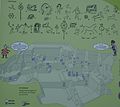Kriemhildenstuhl
| Kriemhildenstuhl | ||
|---|---|---|
 Kriemhildenstuhl |
||
| Data | ||
| place | Bad Dürkheim | |
| Client | Romans | |
| Construction year | Antiquity | |
| Coordinates | 49 ° 27 '50 " N , 8 ° 9' 31.2" E | |
|
|
||
The Kriemhildenstuhl , more rarely also the Krimhildenstuhl (with a short i), on the forest area of the Palatinate district town of Bad Dürkheim ( Rhineland-Palatinate ) is a former Roman quarry that was operated by the 22nd legion of the Roman army around the year 200 AD which was stationed in Mainz .
The Kriemhildenstuhl is owned by the Drachenfels Club . According to the information board of the city of Bad Dürkheim , the site is classified as a monument zone ; the state's list of monuments lists it as an individual monument .
geography
location
The Kriemhildenstuhl is to the left of the Isenach river in the north-west of Bad Dürkheim at 250 m above sea level. NHN on the southeast slope of the 300 m high Kästenberg . This is a southern branch of the Teufelsstein ( 319 m ), which belongs to the Haardt , the eastern edge of the Palatinate Forest towards the Rhine plain . From the hill there is a comprehensive view of the city and over the plain.
Surroundings
The Heidenmauer , a 26 hectare fortified Celtic settlement from the late Hallstatt period, extends directly above the Kriemhildenstuhl . The Brunhildis chair at 213 m a little below the Kriemhilden chair was probably also a Roman quarry. There were other stone quarries by the Romans nearby in the Kallstadter Tälchen and at the Weilerskopf .
Excavation history
In the Middle Ages , the quarry - like the nearby Brunhildis chair - was mistakenly associated with the Germanic Burgundians and the Nibelungenlied . Scientific excavations were carried out in 1884, 1893/94, 1916/17, 1934/35 and 1937–1939. In the time of National Socialism there were - unsuccessful - efforts to prove through excavations that the quarry was an old Germanic cult complex.
Excavations in the second half of the 20th century produced new research results on the technology and work organization of the Romans and brought to light more than the previously known inscriptions.
Excavation results
Technology and work organization
In the semicircular quarry, the whitish quartzitic sandstone of the Karlstal layers of the Middle Buntsandstein was mined. The fact that the stone was extracted near the plateau is probably due to the fact that the stone there was only covered with little soil.
Work was carried out with several working groups, so-called working heads. Individual working heads were 25 m above the next level below.
The shot grooves show that the stone blocks extracted had lengths between 1.20 and 3 m, widths between 0.6 and 1.4 m and heights of 0.6 m. Occasionally, capitals and round stones, which were possibly intended for columns, were also made. The blocks were first hewn free from the rock face on two sides with shot hammers , then the underside was released with trowels . Both types of tools were found during the excavations.
The transport groove in which the blocks were carried down into the valley on runners and rollers can still be seen clearly.
Inscriptions and drawings
Since the lower layers of the quarry were filled with overburden during operation, the traces of Roman tools as well as inscriptions and drawings have been very well preserved.
Work inscriptions
- (angulus) Aici = working head of the Aicus
- (H) ostili Geniali angulus Quin (ti) Purpurionis = The Hostilis Genialis (is) the working head of Quintus Purpurio (assigned)
- (angulus) Septimi VI id Aug = (working head) of Septimus on August 8th (handed over)
Legion inscriptions
- I (ovi) O (ptimo) M (aximo) / ET GENIO / I (m) PERATORE / LVC (Lucio) SEPTIMO / SEVERO VEX (i) L (latio) L (egionis) XXII P (iae) F (idelis) = Consecration to Jupiter and the genius of Emperor Septimius Severus by the division of the 22nd Legion, the righteous and loyal
- ob m (emoriam) Dat (ivi) Pr (o) c (uli) S (igniferi) = in memory of the standard bearer Dativus Proculus
- Natalis m (iles) l (egionis) XXII p (iae) f (idelis) = Natalis, soldier of the 22nd Legion, the righteous and loyal
- Vog (e) llin (us) Perpet (uus) Leg (ionis) XXII P (iae) = Vogellinus Perpetuus, (member) of the 22nd Legion, the righteous
- Gettonius / Ursus Dossus (S) / LE LEG XXII A / LEG XXII P PF = Gettonius, Ursus and Dossus, soldiers of the Legio XXII Antoniniana (?) Legio XXII p (rimigeniae) p (iae) f (idelis) 22nd Legion, the first raised, loyal and righteous
drawings
There are depictions of horses that may have been a badge of the unit working here, as well as depictions of people, phalluses and vulvae . Whether the gender symbols are related to a religious cult or rather correspond to today's latrine smearings cannot be clearly assessed.
In Raddarstellungen and swastikas could be to religious symbols, but also be working marks.
literature
- Hans Schleif : The SS excavation at the “Kriemhildenstuhl” near Bad Dürkheim . 1. Preliminary report. Germania 1938, p. 289-296 .
- Hans Schleif: The SS excavation at the “Kriemhildenstuhl” near Bad Dürkheim . 2. Preliminary report. Germania 1939, p. 340-345 .
- Friedrich Sprater : Limburg and Kriemhildenstuhl . Speyer 1948.
- Helmut Naumann: Brunoldes Stul . In: Communications of the Historical Association of the Palatinate . No. 63 , 1965, pp. 34-94 .
- Josef Röder: The Kriemhildenstuhl . In: Communications of the Historical Association of the Palatinate . No. 67 , 1969, p. 110-132 .
- Helmut Bernhard : The Roman quarry "Krimhildenstuhl" near Bad Dürkheim . In: Karl-Heinz Rothenberger, Karl Scherer, Franz Staab , Jürgen Keddigkeit (eds.): Palatinate history . 2nd, improved edition. tape 1 . Institute for Palatinate History and Folklore, Kaiserslautern 2002.
- Thomas Kreckel: "Sun Shrine" and "Kultburg" . The history of the excavations on the “Heidenmauer” and in the “Kriemhildenstuhl” near Bad Dürkheim in the 1930s. In: Egon Schallmayer , Katharina von Kurzynski (Hrsg.): Archeology and Politics. Archaeological excavations of the 30s and 40s of the 20th century in a contemporary historical context . International conference on the occasion of "75 years of excavations on Glauberg" from October 16 to 17, 2008 in Nidda-Bad Salzhausen. Bonn 2011, p. 271-278 .
Web links
- Location of the Kriemhildenstuhl on: Map service of the landscape information system of the Rhineland-Palatinate nature conservation administration (LANIS map) ( notes )
Individual evidence
- ↑ Helmut Bernhard: The Roman quarry "Krimhildenstuhl" near Bad Dürkheim . 2002, p. 88 ff .
- ↑ The Kriemhildenstuhl. Drachenfels-Club, accessed September 2, 2016 .
- ^ City of Bad Dürkheim: Information board at the Kriemhilden chair .
- ^ General Directorate for Cultural Heritage Rhineland-Palatinate (ed.): Informational directory of cultural monuments - Bad Dürkheim district. Mainz 2020, p. 9 (PDF; 5.1 MB).
- ↑ Map service of the landscape information system of the Rhineland-Palatinate nature conservation administration (LANIS map) ( notes )
- ^ Excavations by Hans Schleif, 1937–1939, see also the article on the Heidenmauer .









